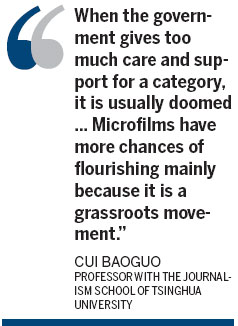Into the unknown
Updated: 2013-10-30 07:35
By Raymond Zhou (China Daily USA)
|
||||||||
All kinds of people and organizations are jumping on the microfilm bandwagon, but few are clear what constitutes a microfilm and whether it brings expected results, reports Raymond Zhou.
When it comes to microfilms, the only thing experts can agree on is that there is little that can be agreed on. Not even the name and the origin.
While the most often English translation is "microfilm", Liu Jun, president of the Beijing Film Academy Library, says it is a misnomer that refers to "microfiche" instead. He adopts the term "microcinema", which he traces back to 1990, first used in San Francisco by Rebecca Barten and David Sherman in their concept of "Total mobile home microcinema". It includes screenings outside the theatrical system, in places like cafes, galleries and other public spaces.
|
Daniel Wu stars in the 90-second Cadillac commercial Touch and Go, considered the very first microfilm in China. Photos Provided to China Daily |
|
Huo Siyan plays a leading role in microfilm Father directed by Xiao Yang and Wang Taili. |
However, that does not gibe well with what many perceive as the key element for microfilms, which is the Internet as its distribution platform. Most people would also exclude the traditional medium of film for recording the video images because they tend to emphasize the low cost and convenience of digital devices as means of production.
In a report conducted by the China Film Education and Information Research Center and released at a forum in Wuhan late September, a 90-second Cadillac commercial, starring Hong Kong heartthrob Daniel Wu, is considered the very first microfilm, at least in China. Titled Touch and Go, it was co-produced by Cadillac and China Film Group. Not only was it extravagantly budgeted, but it was preceded by Dayyan Eng's Bus 44, an 11-minute short that got several minor international awards in 2002 and Hu Ge's The Bloody Case That Started from a Steamed Bun, a 20-minute spoof of Chen Kaige's epic film The Promise, which, in terms of cultural influence, is not rivaled by anything done prior to or since its 2005 debut.
The number of microfilms produced each year, as one may surmise, varies wildly according to the definition of what is a proper microfilm. On one end of the spectrum, any video clip that is not feature-length may qualify, which pushes the total number to an astronomical size. A random individual may shoot a dozen such clips with his cellphone camera in one session, which may or may not contain elements of interest beyond himself and his immediate circle and may be shared on certain online social networks.
A CNNIC (China Internet Network Information Center) report released in June 2013, reveals that 65.9 percent of China's 372 million Internet users are users of online video content. Of these, 96 percent depend on computers, with the ratio of mobile users at 49.4 percent and rising. However, those who produce online video account for only 14.2 percent of the online population and those who shoot and edit is even lower, at 8.2 percent. But that still translates to some 30 million people.
On the other end, the above-mentioned report narrows the definition down to a movie with a complete story, fit for new media platforms and made by professionals. "It should be 30 seconds to 50 minutes in length, 1-7 days in production cycle, thousands or hundreds of thousands of yuan in production cost and with a team of 5 to 10 people." Again, other than the viewing platform, it covers so wide a gamut it can easily absorb most television episodes.

There are dissenting voices of course. Zhou Xing, a professor with Beijing Normal University, defines the length of a microfilm as 5-10 minutes.
The report explicitly excludes traditional shorts and film trailers from the category of microfilm. It designates 2011 as "year zero", citing the release of many such films by video websites and film companies. It predicts that microfilm will expand to tens of billions of yuan in industry size by the year 2018.
Although detailed data is not available, it is clear much of the current revenue comes from advertisers. The bulk of professionally produced microfilms in China is either sponsored by advertisers or are simply commercials with storylines. In other words, what sustains the growth of microfilms may also derail it if a mutually agreeable model of operation between the filmmaker and the advertiser does not emerge.
Xing Beilie, an associate professor with Communication University of China, points out that the billions of yuan some companies promised to invest in microfilms remain lip service. "The pace a steady batch of such films are churned out, at a rate of 400 a month, is Hengdian, the mammoth theme park-cum-backlot where each visitor can order one starring himself for as little as 2,000 yuan ($329). There are all kinds of existing sets and costumes, which do not require extra cost, and templates of shots expedite the operation in the mode of wedding videos. So, one thing missing from these microfilms, if they can be so called, is creativity or individuality."
A recent phenomenon is the level of interest from various government agencies, which have launched all kinds of microfilm festivals and awards, adding up to a total of more than 300 and growing at last count. Some of these operations dole out prizes while others also invest in the production of projects that purport to publicize ideas that represent the values endorsed by these organizations. For example, many local governments use microfilms and their competition to promote the images of the places, which is said to benefit local tourism. This kind of work comes with the same trappings as advertiser-supported projects in that they provide emerging filmmakers with opportunities to work and hone their craft but at the same time may restrict their realm of imagination.
We may not know what will become of microfilms as a category, but there is no doubt it is booming. What is murky is the regulation for it, which so far is made up of only one directive so informal it is titled a "notice", issued jointly by CNNIC and SAPPRFT (the State Administration of Press Publication, Radio, Film and Television).
Essentially, it passes the task of censoring to the websites. Some call it "loose regulation" and some "self-regulation". There are 608 organizations that have obtained licenses from SAPPRET for Internet audio-video programming as of March 2013. Unlike feature films, it is not practical to require each microfilm project to submit for approval of the script and the final edit. So, website staff have to act as guards so to speak.
This worries a lot of people who call for an end to the chaos. But Cui Baoguo, a professor with the Journalism School of Tsinghua University, says the absence of tight regulation is what gives the category hope. "When the government gives too much care and support for a category, it is usually doomed. Look at animation, which is receiving so much blood infusion from all levels of government. Microfilms have more chances of flourishing mainly because it is a grassroots movement."
Contact the writer at raymonzhou@chinadaily.com.cn.
(China Daily USA 10/30/2013 page8)
Most Viewed
Editor's Picks

|

|

|

|

|

|
Today's Top News
China's population policy unchanged
Boston victim's scholarship fund reaches $1m
Beckham picks Miami for MLS franchise
UN urges end of US embargo on Cuba
IMAX: Coming to a home near you
SUNY recruits students in China
NSA denies reports on US spying in Europe
US approves chemical probes against China
US Weekly

|

|















